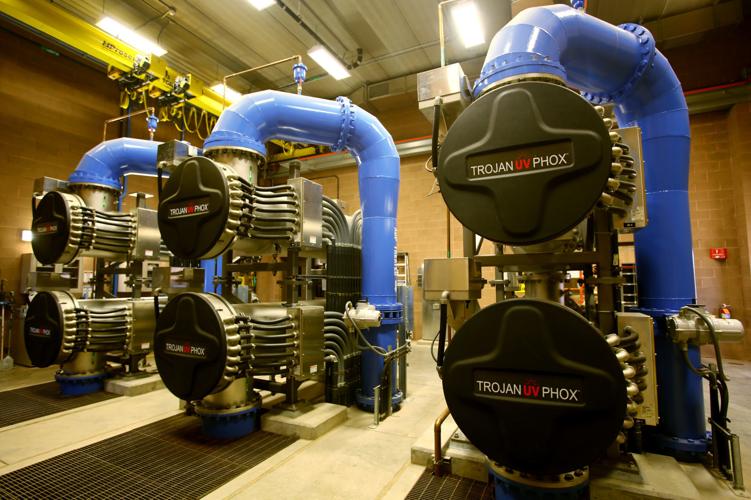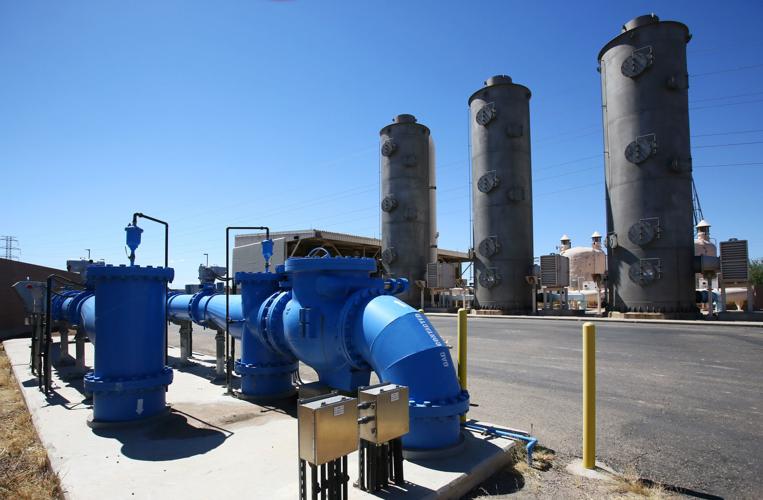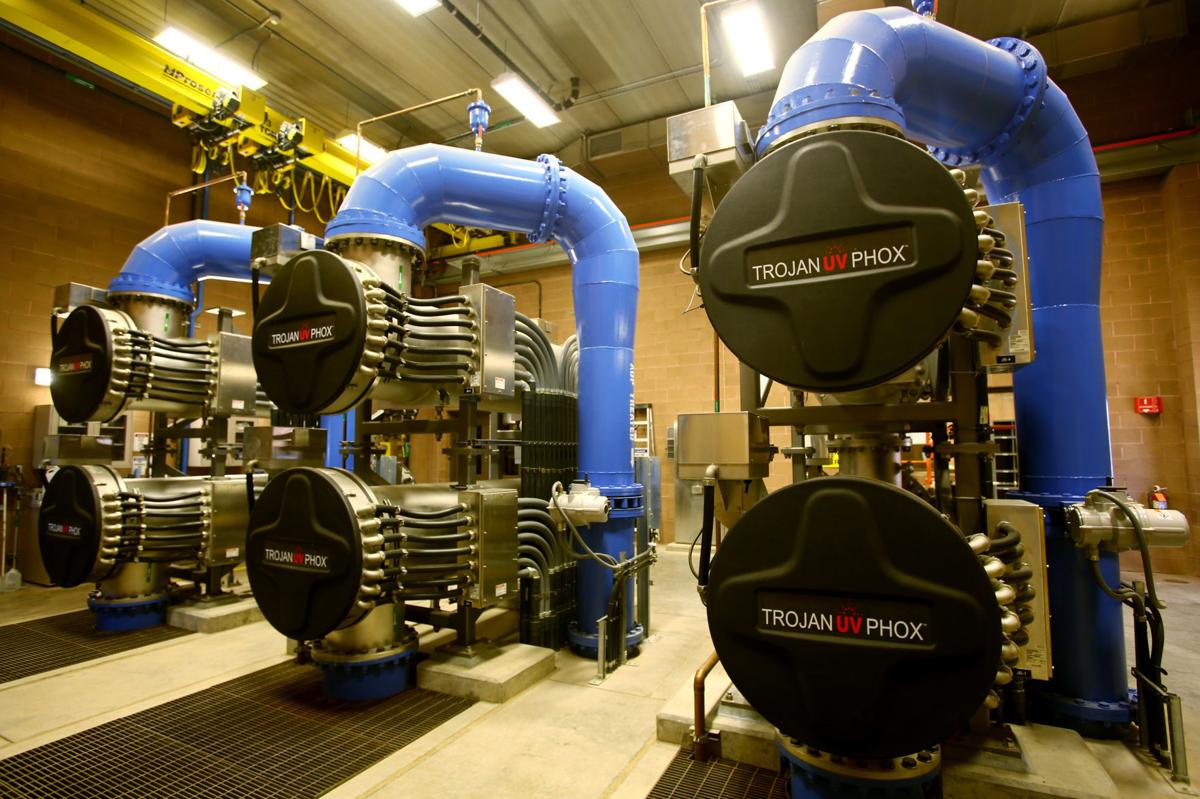Tucson Water recently shut down a treatment plant after discovering it was sending water contaminated with chemical compounds to thousands of residents of downtown and the city’s west and north sides.
Shortly after making that discovery, utility officials also learned that they had mistakenly thought for some time that uncontaminated water was coming out of the plant, which has long treated south-side water pollution.
The utility had been sampling the water at a point its officials thought was connected to the south-side treatment plant, but which actually was getting water from other sources, administrators said last week.
It turned out that water coming out of the treatment plant was now tainted with what’s known as perfluorinated chemicals, also known as PFAS compounds. The treatment plant had been built and later upgraded to treat two other pollutants — the solvent trichloroethylene (TCE) and 1,4-dioxane — but not to treat PFAS.
PFAS is a family of compounds historically used in firefighting foam, in everyday household products such as nonstick frying pans, polishes, carpets, waxes and paints, and in industrial processes. They don’t easily break down in the environment and remain in the body for a long time after being consumed. They have been linked to a long list of illnesses, including possibly cancer in humans.
The levels of the chemicals found in the water coming from the treatment plant were lower than the recommended maximum in official EPA health advisories. But they were higher than a recently released federal study says they should be.
The plant’s water is served to a large V-shaped area, population about 60,000, stretching north from East 29th Street through downtown and flanking Interstate 10. The area spans as far west as the Tucson Mountains and as far east as North Campbell Avenue and beyond. (See map.)
Because the utility hadn’t sampled points in the treatment plant’s water-delivery area until this year, Tucson Water officials say they don’t know how long the contaminated water had been served to customers there.
The utility decided to sample that area this year because it was continuing to find these compounds in other locations, forcing it to shut wells, Tucson Water Director Tim Thomure said.
The south-side treatment plant was put back online Sept. 17, after being closed for more than three weeks while the utility took several short-term measures to reduce contamination levels .
Tucson Water has since taken new samples in the area where the treatment plant’s water is delivered and expects they’ll contain significantly lower levels of the contaminants.
But the utility’s reliance on the wrong sampling point drew sharp criticism from City Council members Steve Kozachik and Regina Romero.
The mistake was “cavalier,” given the city’s longstanding history with water pollution and the community’s sensitivity to it, said Kozachik. Last summer, he was the first city official to tell the public about contamination of other city wells by the same compounds.
“Is it embarrassing? Yeah,” acknowledged Jeff Biggs, Tucson Water’s administrator for strategic initiatives. But, he said, the city had questioned the discrepancy in the pollution levels it was finding and reacted immediately once it learned of the mistake.
“We investigated and we made operational changes to lower the level (of contamination) that we served to the public,” Biggs said.
Kozachik noted that city officials “stand in front of the community all the time, saying that we’re taking seriously our well monitoring, that we’re doing this testing, that we’ve spent tens of millions of dollars” on the treatment plant.
“Then to say that we were monitoring the wrong water main, and we didn’t know where water is coming from is cavalier,” said Kozachik, whose Ward 6 includes much of the downtown area that got PFAS-contaminated water.
Romero, whose Ward 1 also is part of the treatment plant’s service area, said she’s “very, very disappointed” and finds it “very upsetting” that Tucson Water was using the wrong sampling point and that she and other council members hadn’t been told of the PFAS contamination in the area until now.
She noted that the mayor and council and the utility had for years worked to restore Tucson Water’s tarnished reputation, dating to the 1980s, when trichloroethylene was discovered in south-side drinking water.
“We’ve been saying that Tucson Water is transparent, compared to the time of TCE and that we were serving clean water,” Romero said. “Every detail of this bothers me.”
Thomure, Tucson Water’s director, said the error in the original sampling point location “is not something we take lightly, nor is it acceptable.”
Now, the utility will investigate the sampling point’s incorrect placement “and will modify policies and procedures as needed,” Tucson Water spokesman Fernando Molina said.

After water is treated by the AOP (Advanced Oxidation Process) to remove 1,4-dioxane, it is passed to the original Tucson Airport Area Remediation Project (TARP) water treatment facility near Irvington and I-19 on Sept. 26, 2018, which removes the industrial solvent Trichloroethylene (TCE) from nine Tucson Water wells on the Southside. Blowing air in the towers strips the TCE from the water. The aerosolized TCE is captured by carbon filters.
Highest levels found at three sampling sites
The contaminated water had gone through a water-treatment plant, the Tucson Airport Remediation Project, commonly known as the TARP plant.
The plant was first built in 1994 to remove the once-common industrial solvent trichloroethylene from polluted south-side groundwater — a solvent that various aircraft-related industries had dumped into the ground from the late 1940s to the mid-1970s.
In 2014, the plant was upgraded to also remove 1,4-dioxane, an industrial stabilizing agent, from the same groundwater. The dioxane was discovered in the groundwater in 2002.
The plant’s construction was a result of a consent agreement that the city signed with the U.S. Environmental Protection Agency and other parties to start cleaning up the water, long after the TCE was first discovered there in 1981. The plant uses a technology known as advanced oxidation to remove both chemicals.
That water is pumped from the area’s longstanding contamination plume running northwest from Tucson International Airport to near the Irvington Road-Interstate 19 interchange.
The TARP plant was not designed to remove perfluorinated compounds, which utility officials had known for some time also have tainted the south-side wells that supply the contaminated water to TARP.
But for a long time, Tucson Water thought it was removing the PFAS anyway. In part, that’s because the treatment plant contains granulated carbon materials that are thought to be good at removing these compounds from water.
That’s also because the utility had repeatedly found none of the compounds when it sampled for them at a water main lying less than 2 miles north of the Santa Cruz Lane Reservoir where the TARP water is stored for delivery. The reservoir, near the Interstate 19/I-10 interchange, lies about four miles north of the TARP treatment plant along Irvington Road near I-19.
But in late August, Tucson Water found levels of the perfluorinated compounds of up to 30 parts per trillion in the area where water from the treatment plant is delivered.
Levels at or near 30 parts per trillion were found at three points from Grant Road south. It was the first time the city had tested for PFAS there. The 30 figure represents a total of two PFAS compounds known as PFOA and PFOS.
PFAS levels at the northern edge of this service area were, by contrast, “really, really low,” topping at 8.6 parts per trillion, Tucson Water spokesman Molina said.
Thirty is less than half the 70 parts per trillion that the EPA has had since 2016 as a formal health advisory level for the PFAS compounds. But it’s nearly twice as high as a recent federal study concluded is advisable for drinking.
The study from the Agency for Toxic Substances Disease Registry was released in June. That came about a month after the news website Politico reported that the federal government had decided to suppress its results out of concern for their political ramifications.
The EPA is considering whether to impose formal drinking-water limits on the perfluorinated compounds, PFOA and PFOS. It’s also preparing to propose legally designating them as hazardous substances.
In addition, last November, New Jersey became the first state to adopt formal drinking water limits for PFOA and another PFAS compound — 14 and 13 parts per trillion, respectively.
Tucson Water’s current target for PFAS levels in its water supplies is a maximum of 18 parts per trillion when both PFOA and PFOS are combined.
“Something’s
wrong here”
Since 2009, the utility had been sampling its well system and other points in its water-delivery network for the PFAS compounds. It has already shut down three supply wells just north of Davis-Monthan Air Force Base and a half-dozen wells serving customers on the northwest side, including the Continental Ranch area of Marana.
Of the nine south-side wells supplying the TARP system, the three most-contaminated ones ranged from 91 to 190 parts per trillion of the PFAS compounds. At the treatment plant itself, the water averaged about 30 parts per trillion before treatment.
The sampling point north of the Santa Cruz Lane Reservoir was connected to a water main that officials had thought came from the TARP plant, Biggs said. But after PFAS were found throughout the TARP distribution system, “We said wait a minute, something’s wrong here,” he said last week.
Tucson Water immediately started an investigation of the sampling point it had used, Biggs said. The sampling was done through a small spigot, connected to the water main via a steel pipe leading underground in which the spigot was encased. It was most likely installed around February 2000, utility spokesman Molina said.
Looking at old maps of its water system and visiting the area, utility officials discovered that the sampling spigot was actually connected to another main across the street from the water main where most of the TARP water was going, Biggs said. The second main carried water from other sources besides TARP.
Once they realized that, officials for the first time took a sample from the Santa Cruz Lane Reservoir itself. It came out with 30 parts per trillion PFAS. After the samples taken in the TARP delivery area also showed some with levels close to 30, the treatment plant was shut down.
Then, the utility flushed out the water system downstream of the plant by running through it what it said was uncontaminated water from its Central Arizona Project supplies for four or five days. That was to make sure that no contamination was passing through the plant.
Then, it took samples both at the treatment plant and in the distribution system, and found no PFAS compounds. Finally, it shut down the three-most-contaminated south-side wells supplying the TARP plant and started blending the plant water with CAP water coming in at the rate of 2,000 gallons per minute, Biggs said.
These actions were done in consultation with the EPA and the Arizona Department of Environmental Quality, Tucson Water officials said.
“We’ve gotta remember, through the consent decree, we have the responsibility to operate” TARP, Biggs said. “But also, as a drinking-water utility, our main purpose is to provide drinking water that is safe to drink.”
“A relatively
harmless mistake”
City Councilman Paul Durham, whose Ward 3 also includes much of the TARP delivery area, said last week he’s concerned about the contaminated water being served to that area and about the utility’s sampling mistake.
But he’s not alarmed, since the pollution level was less than half that recommended by the EPA health advisory, he said.
Durham said he personally believes that the 70 parts per trillion health advisory level should be lowered, but that for now, it “is all we have to go on.”
“It’s always unfortunate when any kind of mistake occurs, but I believe that it is a relatively harmless mistake. Tucson Water corrected it as soon as they discovered it,” Durham said. “There’s no question that mistakes can be bad, but it could have been far worse.”
But along with Romero and Kozachik, Councilman Richard Fimbres took the utility to task for not disclosing the TARP plant shutdown to the City Council, even though it had told the council about shutting down the three south-side wells with high PFAS levels in an email on Sept. 19.
Kozachik said that with outside attorneys now handling upcoming city-financed litigation against 3M, the Minnesota company that manufactured PFAS compounds for many years, it’s important for the council to get the most up-to-date information on the contamination.
Fimbres, whose district includes the southern end of the TARP delivery area, said he has told the utility to inform him of similar action it takes in the future.
Thomure, Tucson Water’s director, said he accepts this criticism and would ensure that council members are notified of such actions in the future.
Fimbres, however, also noted positive action the city has taken recently to tackle contamination.
For one, the city plans to spend $3.5 million to drill a 10th well to pump groundwater from a section of the contaminated south-side aquifer where the contamination is at its thickest to eradicate the pollution more quickly.
The City Council has also approved spending more money for testing to see if toxic vapors from the groundwater contamination have spread upward into three south-side elementary schools, Fimbres said. They are the C.E. Rose, Elvira and Challenger schools.
“Tucson Water has never knowingly served any water that was above a health or EPA advisory,” Fimbres said in an email to the Star.
“My office, as well as the rest of the mayor and council, work to make sure one of our most precious resources, water, is safe and in abundant supply.”
City plans to remove PFAS from water
Last week, Tucson Water officials said they were awaiting the results of the latest round of sampling from the TARP plant’s water to see if it showed a need for additional quick fixes.
Once that’s taken care of, they’ll work on short- and long-term adjustments to the plant itself so it can remove the PFAS compounds .
Immediate attention will be paid to one of the cleanup methods that the plant employs —what’s known as granular activated carbon. It removes leftover hydrogen peroxide after it’s used at the plant to oxidize and remove TCE from the water, said utility administrator Biggs.
While some forms of the carbon material — which come in the form of tiny black pellets — are designed to also remove PFAS, the kind at the TARP plant aren’t, said Biggs.
Over the next five to six months, the utility will test various varieties of the activated carbon to see which can best remove peroxide and the PFAS chemicals.
The utility will also be looking at what kind of treatment plant to build at the TARP site to replace the existing one — with a new plant to be designed from the start to treat all three pollutants.
Biggs recalled that the utility went through similar rounds of testing and planning a few years ago, before building the advanced oxidation plant to remove dioxane as well as the TCE.
“It’s déjà vu all over again,” Biggs said. “We are reacting to a moving target of health advisories. We are moving as quickly as we can to meet these targets.”







